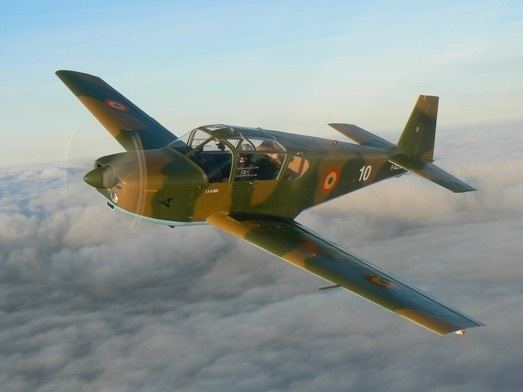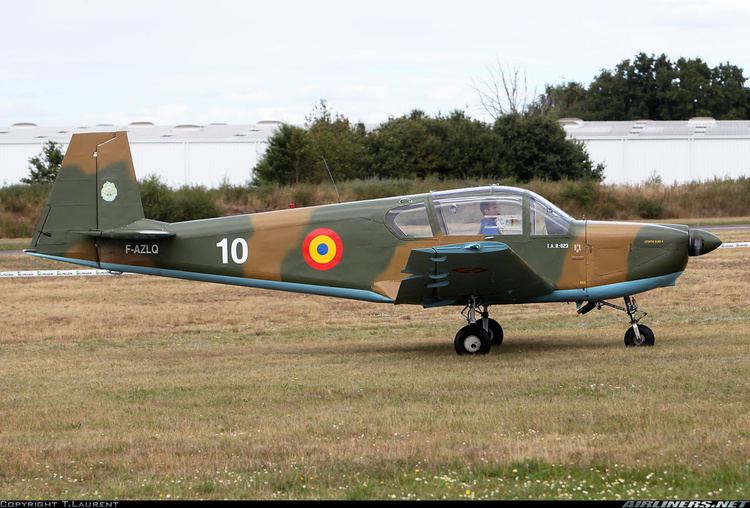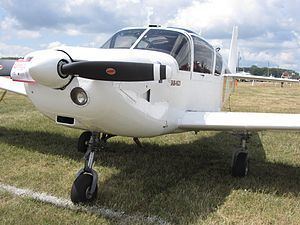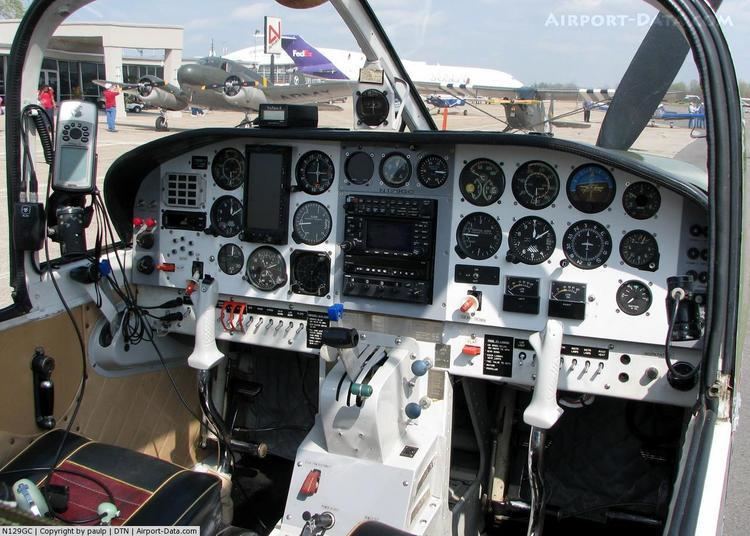Top speed 310 km/h Length 8.24 m | Wingspan 10 m | |
Manufacturer Industria Aeronautică Română | ||
Iar 823 airplane landing
The IAR-823 is a civil and military trainer aircraft built in Romania from 1974 until 1983. It is a conventional low-wing monoplane with retractable tricycle undercarriage. The pilot and instructor sit side-by-side, and two more seats can be fitted behind them. The type was adopted by the Romanian Air Force as a primary trainer, and was also supplied to Romanian and Hungarian aeroclubs and the national flying school of Angola.
Contents
- Iar 823 airplane landing
- Low passes romanian iar 823
- Development
- Operational history
- Variants
- Operators
- Specifications
- References

Low passes romanian iar 823
Development

IAR-823 is the brainchild of one of the greatest figures in post-war Romanian aeronautics: eng. Radu Manicatide. The design was completed under his leadership in 1970, at IMFCA Bucharest (Institutul de Mecanica Fluidelor si Cercetari Aerospatiale - Institute of Fluid Mechanics and Aerospace Research). The prototype's construction began in autumn 1971 at ICA Brasov (now IAR Brasov). This plane, serialled 01, flew for the first time on 10 June 1973. The second plane built participated at the Farnborough Air Show in September 1974, registered YR-MEA.

It is a conventional low-wing monoplane with retractable tricycle undercarriage. Usually a crew of 2 - student and instructor seated side by side. Three more seats are available in the back, bringing the maximum to 5 people, including the pilot(s). This configuration can be replaced by one pilot, a stretcher for one wounded and a paramedic, or one pilot with 500 kg of freight. The last aircraft produced for the Romanian Air Club, registered YR-MEL, was displayed at Le Bourget 1985, together with IAR-831 Pelican registered YR-IGA, a development of the IAR-823, which featured tandem seat arrangement. A more distant relative was the IAR-825TP Triumph (YR-IGB) - based on the Pelican, but with a turboprop engine. Although not envisioned to be used in combat, the aircraft has 2 underwing hardpoints, stressed for 100 kg each. Total maximum allowed weight of external stores is 200 kg

In total 78 planes were produced, with the last built in 1983. The first deliveries took place in 1974. The main customer was the Romanian Air Force, which needed to replace the IAR-813 in the basic flight training role.
Operational history

Initially they were assigned to the 20th Regiment at Boboc, subsequently some were transferred to the 19th Regiment on the grass airfield at Focsani. Small numbers of aircraft were delivered to the Romanian Air Club, being operated at Brasov, Clinceni, Pitesti, Deva and other airfields.

12 IAR-823s were deployed to Negoge, Angola in the frame of "Operation Sirius" in February 1981. There, the Romanians put the bases of the ENAM (national military flight school), also having at their disposal 6 IAR-316B Alouette III and 6 BN-2A Islander, all manufactured in Romania. Flight training began already on 18 May 1981, with the first solo sortie of an Angolan trainee taking place on 30 July 1981 on board the IAR-823. Although both the Alouettes and the 823s could be lightly armed, no combat missions were flown, only training ones. A fatal crash occurred on 6 July 1981, when lt-cdr. Gheorghe Preda and Angolan student Ruy Nelson died on board an IAR-823. In December 1982 the Romanians returned home while the remaining 11 IAR-823 - plus the other aircraft - were handed over to the Angolan Air Force.
In service with the Romanian Air Force there were 4 crashes, including the one in Angola, all fatal. Operations with the IAR-823 became a problem in the early 90's: the fuel required for the type was no longer produced in country and had to be imported from Greece, at a time when budget problems plagued the Air Force. Besides, starting from the mid 80's the much cheaper to operate Yak-52 started entering service. By the mid 90's it had completely taken over the role of the IAR. There is no official date for the IAR-823's retirement from service, but it seems that it was grounded in the 1995-96 timeframe. All the surviving airframes were put in storage at Brasov.
Surplus to requirements and in need of a serious overhaul, they were put up for sale. 10 were bought by a private US customer in 1999, followed by another 36, plus all remaining spare parts in 2000. Another 6 were purchased in October 2004 from the Romanian Air Club, The overwhelming majority of these were restored back to flying condition. In Romania there are 4 aircraft preserved: # 01 at the Central Military Museum in Bucharest, # 15, 19 at the Aviation Museum in Pipera (moved from Otopeni), # 51 at the Henry Coanda Air Force Academy in Brasov.
Variants
Theoretically, there are no versions of the IAR-823, all planes being built to the same specifications. Some of the aircraft were manufactured without hard points.
Production changes included a transition from a tubular canopy to an all fiberglass canopy, a transition from a three piece instrument panel to a single piece slide out instrument panel.
Operators
Romanian Air Force - 56 aircraft serialled in the 01 to 57 range operated until the late 90's by the 19th Liaison School Group at Focsani. Most surviving airframes were sold to private owners in the USA. Angolan Air Force - 12 aircraft (c/n range between 56-67) delivered in 1981 to the ENAM flight school at Negoge. Romanian Air Club - 10 aircraft registered in the YR-MEC to YR-MEL range, all out of service, 6 were sold to private owners in the USA.
Hungarian Air Club - 4 aircraft registered HA-JDL, HA-JDM, HA-JDN and HA-VEZ, operated at the Budaoros airfield, near Budapest. Purchased from the USA. private owners in the USA - 42 aircraft registered since the year 2000 (according to FAA data), most of them being ex-Romanian Air Force examples and possibly a few from the Romanian Air Club. Another 5 planes are unregistered (yet), bringing the total to 47 airframes.
Operators
Specifications
Data from Jane's All The World's Aircraft 1980-81
General characteristics
Performance
Armament
